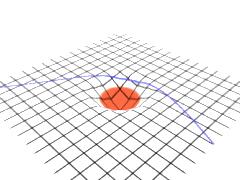|
|
||
| Chrono-Warp | Hyperspace | |
|
Main Links Contact About Us |
So what exactly is the fourth spatial dimension? Length, width, and height are the three spatial
dimensions that we are aware of. We can stick our arms up and down, left and right, and forwards and
backwards. But how can we stick our arms into the fourth dimension? What does Einstein mean when he
says matter-energy warps space into the fourth dimension? To visualize this, we can simplify the
situation into two dimensions.   With this new visual picture, Einstein tried to search for the "theory of everything," a theory that would not just explain gravity, but all of the four forces found in nature (gravity, electromagnetic, nuclear weak, and nuclear strong). He had a geometric explanation of space-time and tried to apply it to explain matter and energy. However, very little was known about the structure of atomic and nuclear matter at the time, and Einstein had a difficult time trying to come up with a theory of unification. In April 1919, Einstein received a letter from Theodr Kaluza. Kaluza explained how he united Einstein’s theory of gravity with Maxwell’s theory of light by introducing a fifth dimension. Kaluza theorized that light (electromagnetic force) is also a disturbance caused by a rippling of higher dimension. The mathematics behind his principle was very elegant, and it was based on pure geometry. Kaluza combined the two greatest field theories in science by arranging them in five dimensions. However, many physicists questioned where the fifth dimension was. In 1926, Oskar Klein made some improvements on the theory. He explained how the fifth dimension is rolled up (that is, if you move into the fifth dimension, you would return back to where you are), and that the size of the fifth dimension should be 10-33 cm (the Planck length). This theory, now known as the Kaluza-Klein theory, could not even be tested because it said the fifth dimension was so small (even smaller than any particle ever seen). Physicists were very skeptical and their sights moved onto other areas of research, namely quantum mechanics. Einstein could not stand quantum theory because it challenged the smooth, geometric interpretation of forces, replacing it with discrete packets of energy. The Kaluza-Klein theory and other geometric theories for unification became yesterday’s news for the next 60 years. Source: ThinkQuest
|
|
| The Team | ||
|
Members Join |
||
| Information | ||
|
Sliders |
||
| The Lab | ||
| Misc. | ||
|
Banners Buttons Terminology Competition |
||
| Message Board | ||
| Go to the boards | ||
| Affiliates | ||
|
1. open 2. open 3. open 4. open 5. open |
||
